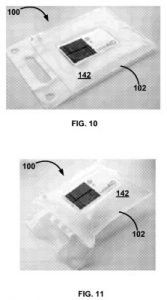Light-emitting diodes (LEDs) are a technology which has been with us for many years now, and yet the full commercial applications of this product have yet to be realized. Highly efficient and durable, residential LEDs use 75 percent less energy and last up to 25 times longer than traditional incandescent bulbs, according to the U.S. Department of Energy (DOE). The widespread use of LEDs could reduce energy demand in the United States by up to 348 terawatt-hours (TWh), the DOE reports. LEDs are a little more expensive than their incandescent or compact fluorescent (CFL) bulbs but it produces much less energy loss as heat and some LED products are Wi-Fi enabled for remote control via smartphone or they can be capable of transmitting light in many colors.
In late 2014, we covered the presentation of that year’s Nobel Prize for Physics to a trio of Japanese scientists who were successful in creating a blue LED in the early 1990s. Their discovery of a blue LED finally enabled the creation of white LED light, which had been a major obstacle on the way towards using LEDs as a lighting solution for residential and commercial applications. LEDs consist of multiple layers of semiconductor material including an n-type layer having a surplus of electrons and a p-type layer having an insufficient amount of electrons. When an electric charge is applied to the semiconductor, positive holes and negative electrons combine at an active layer at the p-n junction to form light. The Japanese scientists engineered a heating process for gallium nitride which created the proper type of p-type layer for blue light.
There’s greater value to the use of LEDs as simply a home lighting solution; the low energy demands and small form factor make them a good tool for emergency lighting situations as well. It’s into this space which solar-powered lighting company LuminAID has been making forays with an innovative technology having applications ranging from disaster relief to recreational outdoor lighting. The company is the brainchild of co-founders Andrea Sreshta and Anna Stork and their flagship product is a solar-rechargeable LED circuit contained within a core which is inflated to diffuse the light and can be collapsed in order to ship flat.
 Earlier this summer, LuminAID issued a press release to announce that it had been issued a patent grant from the U.S. Patent and Trademark Office which covers its inflatable solar-powered LED technology. The patent is U.S. Patent No. 9347629, issued under the title Inflatable Solar-Powered Light. The inflatable solar-powered light claimed in this patent has an expandable bladder and a solar-powered light assembly positioned on a plastic surface and having a circuit board, a rechargeable battery, a solar panel and at least one LED; the plastic covering the solar panel and other components is both substantially transparent and waterproof.
Earlier this summer, LuminAID issued a press release to announce that it had been issued a patent grant from the U.S. Patent and Trademark Office which covers its inflatable solar-powered LED technology. The patent is U.S. Patent No. 9347629, issued under the title Inflatable Solar-Powered Light. The inflatable solar-powered light claimed in this patent has an expandable bladder and a solar-powered light assembly positioned on a plastic surface and having a circuit board, a rechargeable battery, a solar panel and at least one LED; the plastic covering the solar panel and other components is both substantially transparent and waterproof.
As the patent’s background section notes, one of every six people in this world lack access to stable electricity. Often, people without access to electricity will use kerosene, a dangerous and toxic substance that can cost up to 30 percent of a person’s income in underdeveloped regions. This solar-lighting solution achieves the favorable outcomes of being easy to transport while eliminating recurring energy costs as well as the limited resources of non-rechargeable batteries.
LuminAID offers a few variations on its inflatable solar-powered light technology to consumers. The LuminAID PackLite 16 offers a maximum brightness of 65 lumens with various brightness settings, including emergency flashing; the unit charges on solar energy within seven to ten hours and can provide 30 hours of continuous light on the lowest setting after a full charge. The LuminAID PackLite 12 comes with a handle for use as a portable lantern and provides a maximum brightness of 45 lumens or 12 hours of light on the lowest brightness. LuminAID also offers the PackLite Spectra, a model closely reminiscent of the PackLate 12 offering eight color modes plus white light and a multi-color fade.
The company has been earning a bit of acclaim from media publications for its technology. Tech news outlet CNET has reported that, when deflated, 50 LuminAID solar-powered lights can ship in the same amount of space as eight flashlights. Popular Science also gave the product a glowing review as a useful accessory for campers or hikers.
The product hasn’t just attracted media attention, however. It also has wooed the financial backing of Mark Cuban, one of the regular business investors featured on hit reality TV show Shark Tank. Cuban, a billionaire tech investor and owner of the NBA’s Dallas Mavericks, offered to invest in LuminAID’s business on an episode of Shark Tank airing in February 2015. According to reports from The Chicago Tribune, Cuban invested $200,000 which LuminAID’s founders were planning to use on financing expansions of sales teams and to launch new products. All five investors on that particular episode offered to invest in LuminAID but Sreshta and Stork agreed to Cuban’s investment offer in exchange for a 15 percent stake in the company as well as the option to lead a $300,000 round of financing in the future.
LuminAID may not be a household name in America but it is making its presence felt in more than 70 countries. A group of humanitarian organizations have been using LuminAID products in their operations including ShelterBox, Médecines Sans Frontières (Doctors Without Borders) and the United Nations Population Fund. This January, business magazine Entrepreneur was reporting that LuminAID had completed $2 million in sales through the first nine months of 2015.
The LuminAID story is also interesting because both of the named inventors are women. Specifically, the ‘629 patent issued to LuminAID only lists co-founders Anna Stork and Andrea Sreshta as inventors.
Although the number of patents issued to women inventors still pales in comparison to patents issued to male inventors, the number of patented women inventors has quadrupled over the last three decades. Still, fewer than 20% of patents have at least one woman inventor. Further, a 2012 working paper of the National Bureau of Economic Research (NBER) found that women held a very small percentage of intellectual property assets, including only 5.5 percent of commercialized patents; the study also noted that there was very little difference in patenting rates among women with science or engineering degrees and women without those degrees.
“They are doing amazing things to help disaster stricken areas,” Cuban explained via e-mail when reached for comment.

![[IPWatchdog Logo]](https://ipwatchdog.com/wp-content/themes/IPWatchdog%20-%202023/assets/images/temp/logo-small@2x.png)



![[Advertisement]](https://ipwatchdog.com/wp-content/uploads/2024/04/Patent-Litigation-Masters-2024-sidebar-early-bird-ends-Apr-21-last-chance-700x500-1.jpg)

![[Advertisement]](https://ipwatchdog.com/wp-content/uploads/2021/12/WEBINAR-336-x-280-px.png)
![[Advertisement]](https://ipwatchdog.com/wp-content/uploads/2021/12/2021-Patent-Practice-on-Demand-recorded-Feb-2021-336-x-280.jpg)
![[Advertisement]](https://ipwatchdog.com/wp-content/uploads/2021/12/Ad-4-The-Invent-Patent-System™.png)






Join the Discussion
One comment so far.
tim
August 6, 2016 05:10 pmThis patent should be voided. The solar light inside a plastic container has been on sale for at least one year in the form of a round cylinder with basically flat ends for camping. Beside Mark Cuban hates patents and should not be able to get one for himself or any of his business interests. He has been on record as someone that believes patents stifle innovation. Stick that intio your basket Mr Cuban.